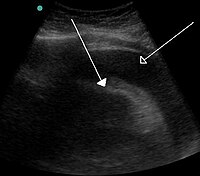
Photo from wikipedia
OBJECTIVE To describe the clinical signs, clinical course, and prognosis of suspected left atrial rupture (LAR) secondary to myxomatous mitral valve disease (MMVD) in dogs and to compare them with… Click to show full abstract
OBJECTIVE To describe the clinical signs, clinical course, and prognosis of suspected left atrial rupture (LAR) secondary to myxomatous mitral valve disease (MMVD) in dogs and to compare them with dogs with suspected neoplastic cardiac tamponade (NCT). DESIGN Retrospective study from November 2015 to October 2019 SETTING: An out-of-hours Emergency Animal Hospital. ANIMALS Twenty-three dogs with LAR secondary to MMVD (LAR group) and 47 dogs with NCT (NCT group). INTERVENTIONS None. MEASUREMENTS AND MAIN RESULTS The following were the characteristics of the study population (LAR group vs NCT groups) with P < 0.05 as the significance threshold: male sex, 83% vs 66%; median age, 11.9 vs 12.5 years; and median weight, 3.8 vs 6.4 kg (P < 0.001). Chihuahuas and Miniature Dachshunds were overrepresented in the LAR and NCT groups, respectively. Statistically different clinical findings between the 2 groups were as follows (LAR vs NCT): pulmonary edema, 43% vs 0%; pericardial thrombus, 70% vs 6% (P < 0.001); ineffectiveness of pericardiocentesis (whether aspiration of pericardial fluid was successful or not), 58% vs 2% (P < 0.001); mortality rate within 48 hours of visiting hospital, 35% vs 9% (P < 0.01). No significant difference was observed in survival time after discharge between the 2 groups. CONCLUSIONS The proportion of dogs with a diagnosis of LAR secondary to MMVD in dogs with cardiac tamponade was higher than the previously reported rate. Furthermore, the frequency of pulmonary edema, ineffectiveness of pericardiocentesis, and short-term mortality rate was higher in the LAR group than in the NCT group.
Journal Title: Journal of veterinary emergency and critical care
Year Published: 2022
Link to full text (if available)
Share on Social Media: Sign Up to like & get
recommendations!